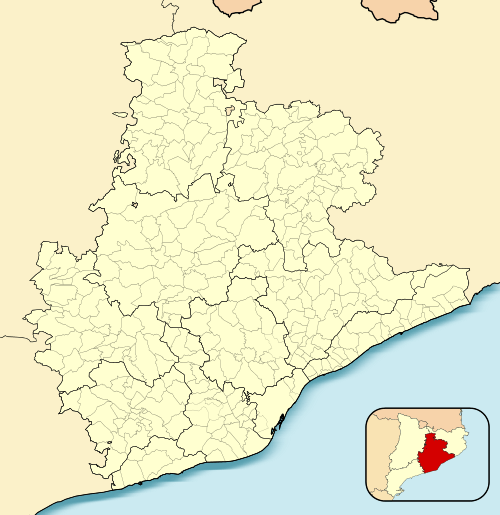Sant Celoni
Sant Celoni (Catalan pronunciation: [ˈsan səˈlɔni]) is a municipality in the comarca of the Vallès Oriental in Catalonia, Spain. It is situated in the valley of the Tordera river between the ranges of Montseny and Montnegre. The main part of the town is on the left bank of the river. The former municipalities of Montnegre and Olzinelles now form part of the municipality of sant Celoni, which has the largest area in the comarca. The municipality is served by the AP-7 Motorway and the C-251 road, as well as by a station on the RENFE railway line between Barcelona and Girona.
Sant Celoni | |
|---|---|
View of Sant Celoni with the Montseny Massif in the background | |
 Flag  Coat of arms | |
 Sant Celoni Location in Catalonia  Sant Celoni Sant Celoni (Spain) | |
| Coordinates: 41°41′24″N 2°29′24″E | |
| Country | |
| Community | |
| Province | Barcelona |
| Comarca | Vallès Oriental |
| Government | |
| • Mayor | Francesc Deulofeu Fontanillas (2015)[1] (CIU) |
| Area | |
| • Total | 65.2 km2 (25.2 sq mi) |
| Elevation | 152 m (499 ft) |
| Population (2018)[3] | |
| • Total | 17,754 |
| • Density | 270/km2 (710/sq mi) |
| Demonym(s) | Celoní, celonina |
| Website | santceloni |

History
The town of Sant Celoni was named after chapel built towards the 11th century at the foot of the river Pertegàs. Sant Celoni is the translation from the Latin Sanctum Celedonium and Sancti Celedonii, which refers to Saint Celedonius. There have been many variations on the name through the centuries: Sancti Celidonia, Sant Celdoni, Sent Salony, Sanseloni, San Celoni.
Francesc Sabaté Llopart was killed in Sant Celoni in 1960.
Economy
The agricultural sector has suffered a setback and a loss of importance over the years. The only farming reduces the crop of cereals and fodder.
The industry was capitalized on the economic growth of the Sant Celoni. The chemical industry has a strong presence in the town. There are also a large number of industries in the metal and electronics that have experienced strong growth in recent years. The high rate of business growth in the area has encouraged the development of new industrial estates, which in turn have led to the advent of industries that were not originally in the territory.
The construction has a strong presence in the area, which has experienced very significant growth in recent years.
Sant Celoni remains also an important and modern center of trade, complete with attractive weekly market on Wednesday, attracts many people from the surrounding area. In addition, it has recently built a shopping center with cinemas, bars and restaurants, pubs, supermarket, shops...
In 2001, only 1.4% of the population was employed in agriculture, 11.1% in construction, 30.5% in industry and what is more important are the services with 57%.
Demography
| 1900 | 1930 | 1950 | 1970 | 1986 | 2012 |
|---|---|---|---|---|---|
| 3,301 | 4,192 | 4,923 | 9,325 | 11,275 | 17,076 |
Communications
The town of Sant Celoni has good communication links. The AP-7 motorway, the C-35 trunk road, and a railway link Sant Celoni to the rest of Catalonia and France. There is also a reasonable bus network.
References
- "Ajuntament de Sant Celoni". Generalitat of Catalonia. Retrieved 2015-11-13.
- "El municipi en xifres: Sant Celoni". Statistical Institute of Catalonia. Retrieved 2015-11-23.
- Municipal Register of Spain 2018. National Statistics Institute.
- Panareda Clopés, Josep Maria; Rios Calvet, Jaume; Rabella Vives, Josep Maria (1989). Guia de Catalunya, Barcelona: Caixa de Catalunya. ISBN 84-87135-01-3 (Spanish). ISBN 84-87135-02-1 (Catalan).
External links
| Wikimedia Commons has media related to Sant Celoni. |
- Official website (in Catalan)
- Government data pages (in Catalan)
.svg.png)